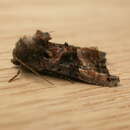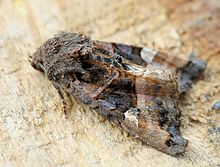en
names in breadcrumbs


Gwyfyn sy'n perthyn i urdd y Lepidoptera yw gwyfyn llenni crychlyd bach, sy'n enw gwrywaidd; yr enw lluosog ydy gwyfynod llenni crychlyd bach; yr enw Saesneg yw Small Angle Shades, a'r enw gwyddonol yw Euplexia lucipara.[1][2]
Mae i'w ganfod ledled Ewrop. Gwyfyn bychan ydyw gyda lled ei adenydd yn 30–35 mm. Mae'n hedfan yn y nos a hynny rhwng Mehefin a Gorffennaf.
Rhedyn yw ei hoff fwyd ond mae hefyd i'w weld yn bwyta dail y planhigion canlynol:
Gellir dosbarthu'r pryfaid (neu'r Insecta) sy'n perthyn i'r Urdd a elwir yn Lepidoptera yn ddwy ran: y gloynnod byw a'r gwyfynod. Mae'r dosbarthiad hwn yn cynnyws mwy na 180,000 o rywogaethau mewn tua 128 o deuluoedd.
Wedi deor o'i ŵy mae'r gwyfyn llenni crychlyd bach yn lindysyn sy'n bwyta llawer o ddail, ac wedyn mae'n troi i fod yn chwiler. Daw allan o'r chwiler ar ôl rhai wythnosau. Mae pedwar cyfnod yng nghylchred bywyd glöynnod byw a gwyfynod: ŵy, lindysyn, chwiler ac oedolyn.
Gwyfyn sy'n perthyn i urdd y Lepidoptera yw gwyfyn llenni crychlyd bach, sy'n enw gwrywaidd; yr enw lluosog ydy gwyfynod llenni crychlyd bach; yr enw Saesneg yw Small Angle Shades, a'r enw gwyddonol yw Euplexia lucipara.
Mae i'w ganfod ledled Ewrop. Gwyfyn bychan ydyw gyda lled ei adenydd yn 30–35 mm. Mae'n hedfan yn y nos a hynny rhwng Mehefin a Gorffennaf.
Die Gelbfleck-Waldschatteneule oder Purpurglanzeule (Euplexia lucipara) ist ein Schmetterling (Nachtfalter) aus der Familie der Eulenfalter (Noctuidae).
Die Falter erreichen eine Flügelspannweite von 27 bis 32 Millimetern. Ihre Vorderflügel haben eine rötlichbraune bis violettbraune Grundfarbe. Das Mittelfeld ist dunkel und grenzt am Flügelvorderrand an einen gelblich-weißen, häufig schmutzig dunkel gezeichneten Fleck an. Der Außenrand der Vorderflügel ist dunkelbraun.
Die Raupen werden etwa 35 Millimeter lang und sind grün oder bräunlich gefärbt. Sie tragen entlang des Rückens eine sehr feine Linie aus hellen Strichen und beidseits davon nur schwach erkennbare, dunkle schräge Linien. Am elften Segment besitzen die Tiere zwei kleine weiße Punkte.
Die Tiere kommen in Mitteleuropa fast überall und sehr häufig vor. Sie leben an halbschattigen, bis schattigen, oft feuchten Orten wie etwa in Wäldern, Flussauen, Mooren und Heiden, aber auch in Parks und Gärten.
Die Falter lassen sich sowohl durch künstliches Licht, als auch durch Köder anlocken.
Die Gelbfleck-Waldschatteneule bildet eine Generation im Jahr, die von Ende Mai bis Ende Juli fliegt. Die Raupen sind von Juli bis Anfang Oktober anzutreffen. Gelegentlich wird auch eine unvollständige zweite Generation hervorgebracht.
Die Raupen ernähren sich von sehr vielen verschiedenen krautigen und verholzten Pflanzen, wie beispielsweise von Echtem Wurmfarn (Dryopteris filix-mas), Gemeiner Hasel (Corylus avellana), Großer Brennnessel (Urtica dioica), Gewöhnlicher Waldrebe (Clematis vitalba), Großem Springkraut (Impatiens noli-tangere), Ampfer (Rumex), Weidenröschen (Epilobium), Ziesten (Stachys), Schöllkraut (Chelidonium majus), oder Brombeeren (Rubus fruticosus).
Die Raupen sind überwiegend nachtaktiv, fressen aber auch tagsüber bei Schlechtwetter. Die Verpuppung erfolgt in einer Kammer im Erdreich. Die Puppe überwintert.

Die Gelbfleck-Waldschatteneule oder Purpurglanzeule (Euplexia lucipara) ist ein Schmetterling (Nachtfalter) aus der Familie der Eulenfalter (Noctuidae).
The small angle shades (Euplexia lucipara) is a moth of the family Noctuidae. It is distributed throughout the Palearctic. The species was first described by Carl Linnaeus in his 1758 10th edition of Systema Naturae.
As the common name suggests, this species is closely related to the angle shades (Phlogophora meticulosa), and is considerably smaller (wingspan 30–35 mm), but does not especially resemble that species. The forewings are dark brown with a broad, pale subterminal band, wider and paler towards the costa. The hindwings are whitish at the base, graduating to brown at the margins. In the British Isles this species flies at night in June and July, with a second generation sometimes emerging in September. It is attracted to light and sugar.
It is found throughout Europe, in Algeria, in western Asia and through the Palearctic to Siberia, China, and Japan.
Forewing rufous ochreous tinged with purplish and mixed with olive brown; median area, a triangular blotch on inner margin near base, and a narrow praesubmarginal cloud deep olive; costa to beyond middle, the terminal area, and the orbicular stigma leaden purple; lines indistinct, the outer and inner approximating on inner margin; claviform stigma olive, dark edged; orbicular roundish, oblique, with paler ring; reniform conspicuously whitish, containing a double brown lunule; submarginal line pale, waved; veins towards termen dotted dark and pale; hindwing ochreous with dark cell mark and veins, darker in terminal half where there is visible a dark pale-edged outer and submarginal line.[1]
Larva velvety green with darker green oblique subdorsal stripes; tubercles pale; spiracular line yellowish white; 11th segment slightly swollen, with a pair of white dots; head green.
The larvae often feed on ferns and the species is usually associated with them. Other recorded food plants include birch, false bindweed, dogwood, larkspur, willowherb, ash, ivy, lettuce, privet, loosestrife, oak, buttercup, currant, raspberry, willow, tomato, coltsfoot, nettle, and guelder rose.[2] The species overwinters as pupae.
Illustration from British Entomology, Volume 5, by John Curtis
The small angle shades (Euplexia lucipara) is a moth of the family Noctuidae. It is distributed throughout the Palearctic. The species was first described by Carl Linnaeus in his 1758 10th edition of Systema Naturae.
As the common name suggests, this species is closely related to the angle shades (Phlogophora meticulosa), and is considerably smaller (wingspan 30–35 mm), but does not especially resemble that species. The forewings are dark brown with a broad, pale subterminal band, wider and paler towards the costa. The hindwings are whitish at the base, graduating to brown at the margins. In the British Isles this species flies at night in June and July, with a second generation sometimes emerging in September. It is attracted to light and sugar.
Euplexia lucipara, la Brillante, est une espèce de lépidoptères de la famille des Noctuidae et du genre Euplexia.
Comme le suggère le nom vernaculaire anglophone (Small Angle Shades), cette espèce serait étroitement liée à Angle Shades, la Méticuleuse (Phlogophora meticulosa). Pourtant, ces deux espèces ne se ressemblent guère, et Euplexia lucipara est considérablement plus petite (envergure 30-35 mm). Les ailes antérieures sont brun foncé ornées d'une large bande de plus en plus pâle jusqu'aux bords extérieurs de l'aile. Les ailes postérieures sont blanchâtres à la base, graduellement brunies jusqu'aux marges.
On la trouve dans la majeure partie de l'Europe. Partout en France, plus localisée dans le sud et en altitude.
Cette espèce nocturne vole de juin à juillet avec une deuxième génération émergeant parfois en août-septembre, saison de vol valable pour les îles Britanniques. Le papillon est attiré de manière équivalente par la lumière et par le sucre.
La larve, active la nuit, s'alimente souvent de fougères auxquelles elle est habituellement associée. Mais son alimentation est plus variée. Cette espèce hiberne sous forme de chrysalide dans le sol.
Athyrium, Betula, Calystegia, Cornus, Delphinium, Epilobium, Fraxinus, Hedera, Lactuca, Ligustrum, Lysimachia, Pteridium, Quercus, Ranunculus, Ribes, Rubus, Salix, Solanum, Tussilago, Urtica, Viburnum.
Euplexia lucipara, la Brillante, est une espèce de lépidoptères de la famille des Noctuidae et du genre Euplexia.
De levervlek (Euplexia lucipara) is een nachtvlinder uit de familie Noctuidae, de uilen. De voorvleugellengte bedraagt tussen de 14 en 16 millimeter. De soort komt voor in heel Europa. Hij overwintert als pop.
De levervlek heeft als waardplanten allerlei bomen, struiken en kruidachtige planten, zoals vooral berk en varens.
De levervlek is in Nederland en België een algemene soort, die verspreid over het hele gebied kan worden gezien. De vlinder kent één generatie die vliegt van begin mei tot begin augustus.
De levervlek (Euplexia lucipara) is een nachtvlinder uit de familie Noctuidae, de uilen. De voorvleugellengte bedraagt tussen de 14 en 16 millimeter. De soort komt voor in heel Europa. Hij overwintert als pop.
Lyktebærerfly (Euplexia lucipara) er en sommerfugl som tilhører familien nattfly (Noctuidae). Den finnes over hele Sør-Norge.
Et middelsstort (vingespenn 32 – 36 mm), brunlig nattfly med et karakteristisk vingemønster. Forkroppen er mørkgrå. Forvingen er lyst brungrå med et bredt, mørkt brungrått tverrbånd i midten. Den er også mørkgrå langs den litt bølgete ytterkanten. Nyremerket er skinnende hvitt, dette er "lykten" i det norske navnet og også i det latinske artsnavnet. Ringmerket er brungrått, lysere enn det omkringliggende området. Bakvingen er brungrå, lysere ved roten, med en hvit flekk i bakhjørnet.
Arten finnes i løv- og blandingsskog, i skogkanter og i hager. Larven kan finnes på mange ulike urter, busker og trær. De voksne sommerfuglene fly om natten i mai – juli og kommer gjerne til lys.
Lyktebærerflyet forekommer i Nord-Afrika, i det meste av Europa og videre østover til Kina, Korea og Japan. I Norge er den vanlig over hele Sør-Norge.
Lyktebærerfly (Euplexia lucipara) er en sommerfugl som tilhører familien nattfly (Noctuidae). Den finnes over hele Sør-Norge.
Euplexia lucipara é uma espécie de insetos lepidópteros, mais especificamente de traças, pertencente à família Noctuidae.[1]
A autoridade científica da espécie é Linnaeus, tendo sido descrita no ano de 1758.
Trata-se de uma espécie presente no território português.
Euplexia lucipara é uma espécie de insetos lepidópteros, mais especificamente de traças, pertencente à família Noctuidae.
A autoridade científica da espécie é Linnaeus, tendo sido descrita no ano de 1758.
Trata-se de uma espécie presente no território português.
Euplexia lucipara là một loài bướm đêm trong họ Noctuidae.[1][2]